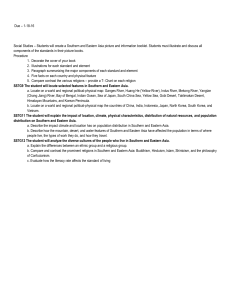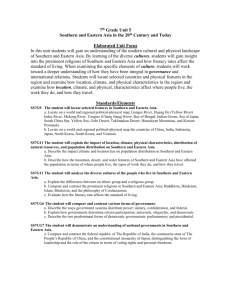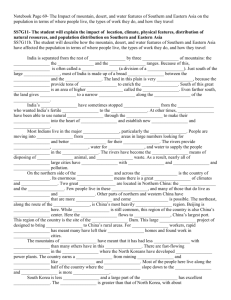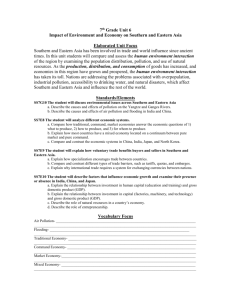Eastern and Southern Asia Essential Questions
advertisement
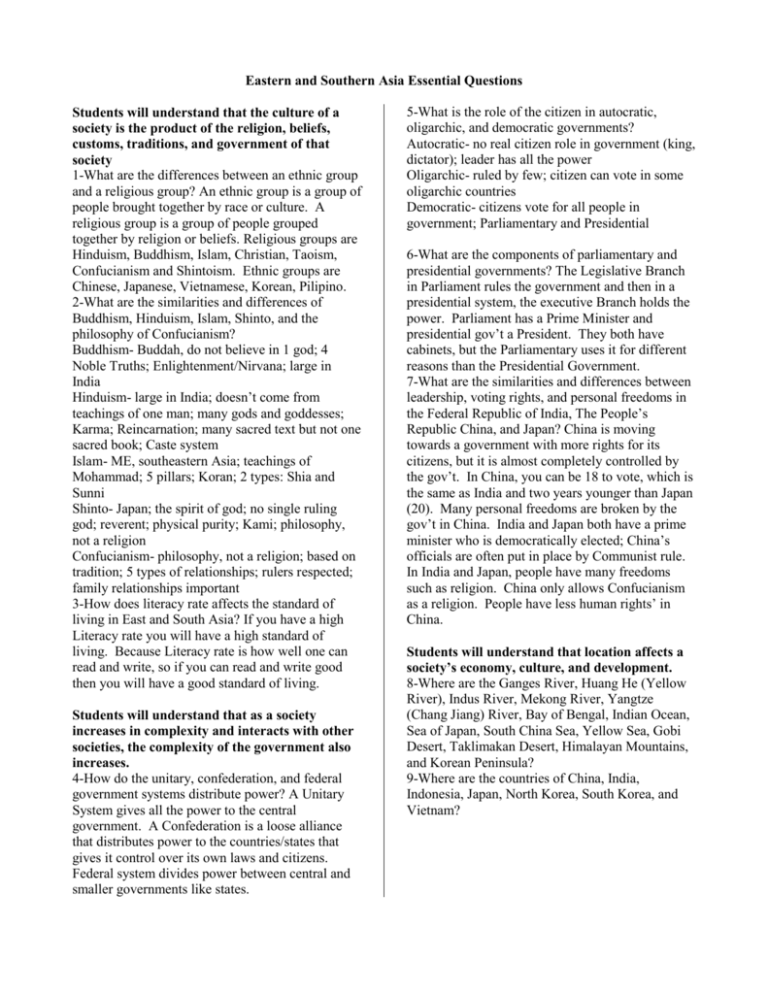
Eastern and Southern Asia Essential Questions Students will understand that the culture of a society is the product of the religion, beliefs, customs, traditions, and government of that society 1-What are the differences between an ethnic group and a religious group? An ethnic group is a group of people brought together by race or culture. A religious group is a group of people grouped together by religion or beliefs. Religious groups are Hinduism, Buddhism, Islam, Christian, Taoism, Confucianism and Shintoism. Ethnic groups are Chinese, Japanese, Vietnamese, Korean, Pilipino. 2-What are the similarities and differences of Buddhism, Hinduism, Islam, Shinto, and the philosophy of Confucianism? Buddhism- Buddah, do not believe in 1 god; 4 Noble Truths; Enlightenment/Nirvana; large in India Hinduism- large in India; doesn’t come from teachings of one man; many gods and goddesses; Karma; Reincarnation; many sacred text but not one sacred book; Caste system Islam- ME, southeastern Asia; teachings of Mohammad; 5 pillars; Koran; 2 types: Shia and Sunni Shinto- Japan; the spirit of god; no single ruling god; reverent; physical purity; Kami; philosophy, not a religion Confucianism- philosophy, not a religion; based on tradition; 5 types of relationships; rulers respected; family relationships important 3-How does literacy rate affects the standard of living in East and South Asia? If you have a high Literacy rate you will have a high standard of living. Because Literacy rate is how well one can read and write, so if you can read and write good then you will have a good standard of living. Students will understand that as a society increases in complexity and interacts with other societies, the complexity of the government also increases. 4-How do the unitary, confederation, and federal government systems distribute power? A Unitary System gives all the power to the central government. A Confederation is a loose alliance that distributes power to the countries/states that gives it control over its own laws and citizens. Federal system divides power between central and smaller governments like states. 5-What is the role of the citizen in autocratic, oligarchic, and democratic governments? Autocratic- no real citizen role in government (king, dictator); leader has all the power Oligarchic- ruled by few; citizen can vote in some oligarchic countries Democratic- citizens vote for all people in government; Parliamentary and Presidential 6-What are the components of parliamentary and presidential governments? The Legislative Branch in Parliament rules the government and then in a presidential system, the executive Branch holds the power. Parliament has a Prime Minister and presidential gov’t a President. They both have cabinets, but the Parliamentary uses it for different reasons than the Presidential Government. 7-What are the similarities and differences between leadership, voting rights, and personal freedoms in the Federal Republic of India, The People’s Republic China, and Japan? China is moving towards a government with more rights for its citizens, but it is almost completely controlled by the gov’t. In China, you can be 18 to vote, which is the same as India and two years younger than Japan (20). Many personal freedoms are broken by the gov’t in China. India and Japan both have a prime minister who is democratically elected; China’s officials are often put in place by Communist rule. In India and Japan, people have many freedoms such as religion. China only allows Confucianism as a religion. People have less human rights’ in China. Students will understand that location affects a society’s economy, culture, and development. 8-Where are the Ganges River, Huang He (Yellow River), Indus River, Mekong River, Yangtze (Chang Jiang) River, Bay of Bengal, Indian Ocean, Sea of Japan, South China Sea, Yellow Sea, Gobi Desert, Taklimakan Desert, Himalayan Mountains, and Korean Peninsula? 9-Where are the countries of China, India, Indonesia, Japan, North Korea, South Korea, and Vietnam? 10-What is the impact of climate and location on population distribution in Southern and Eastern Asia? The biggest impact on location and climate of southern and eastern Asia is basically the location. A large part of Asia is desert, but much of southern and southeastern Asia gets large amounts of rain. About 90% of China’s people live plateaus, plains and river valleys. This is where there is fertile soil and plentiful rain. Since about half of India’s land is suitable for crops, most Indians work in agriculture. The population is lower in the mountains of China and Japan b/c the winters are long and cold and summers are short. Desert areas of China have very low populations, because of the harsh climate. 11-How do the mountain, desert, and water features of Southern and Eastern Asia affect the population in terms of where people live, the types of work they do, and how they travel? In Southern Asia, there is a very sacred river called the Ganges River that flows through India and Bangladesh. The population around there is mostly Hindu since the river is named after a Hindu goddess. There is also the Gobi desert that is very close to the center of China, so few people live there. If one lives around a river or ocean, their work will revolve around the water industries. People travel easier by rivers. The student will understand that the production, distribution, and consumption of goods/services produced by the society are affected by the location, customs, beliefs, and laws of the society. 12-What are the advantages and disadvantages of specialization on trade between countries in Southern and Eastern Asia? An advantage is that a country can get what it needs at the lowest cost (efficiency) when it is produced by another country that specializes it. A disadvantage is opportunity cost. This is the amount of money that they could have if they specialized in another item. Japan specializes in making cars so other countries buy a lot of cars from them. They also make a lot of pencils but they don’t specialize in them so they don’t make as much money. 13-How are tariffs, quotas, and embargos barriers to trade in Southern and Eastern Asia? Not all countries have all the products that they need. Embargos prevent transfer of goods between two or more countries. A tariff is a tax on imported goods. Taxes can make the price of a good higher. One country may trade all the time with another country. Some countries make deals with one another where they must trade a certain number of goods (quota) 14-Why does international trade require a system for exchanging currencies between nations? Every country does not use the same type of money so international trade requires a system for exchanging currency b/w nations. Money from one country must be converted into the currency of the other country to pay for goods in that country. This system is called foreign exchange. 15-What is the relationship between investment in human capital (education and training) and gross domestic product (GDP)? Human Capital are the workers of a businesses or company. The workers have to be trained and educated on how to do their job. The GDP is the total market value of the goods and services produced by a country’s economy during a specific period of time. Investment in human capital delivers long-lasting rewards. Some studies have shown that investment in education and skills training leads to a higher GDP. If demand for a product goes up, then GDP will too. 16-What is the relationship between investment in capital (factories, machinery, and technology) and gross domestic product (GDP)? The higher the GDP, the more capital a country can afford. The GDP is a measurement of how well an economy is doing. Capital is machinery and factories. Investing your money is a smart move to enable your production rate and have a higher economic rate. 17-How do natural resources affect a countries’ economy? A country may have a resource another country may have the need for. So one country sells to another and gets money, making the economy stronger. Some countries have very few natural resources (Japan) and have to import many common natural resources. 18-What is the role of entrepreneurship in Southern and Eastern Asia? Entrepreneurship is rising dramatically in India and China. Entrepreneurs take a risk of starting a business. There are many entrepreneurs in Asia with new ideas and inventions. They have many ideas for their countries. Businesses must make a profit in order to stay in business. 19-How do the traditional, command, and market economies of Southern and Eastern Asian countries answer the economic questions of (1) what to produce, (2) how to produce, and (3) for whom to produce? A command economic system tells industries and people what to produce, how to produce it and for whom to produce it. The government has control. In a market economy, people in a country can decide what to buy, how much can buy and for whom they buy. The Mixed economic system is in the middle and many countries have this kind of economic system. They take something from both sides of the situation. A traditional economic system is based on a system of bartering and usually takes place in remote regions. 20-Where are the economic systems of Southern and Eastern Asia located on a continuum between pure market and pure command? Japan is located centrally on the continuum because it is purely mixed. North Korea would fall directly command because of the communist control in the country. India and China fall between command and mixed. 21-What are the similarities and differences between the economic systems in China, India, Japan, and North Korea.? Japan has one of the strongest economies in the world. It is mixed. China is growing out of a total command economy, trying to become mixed. India is mixed as well, but poverty plays a role. North Korea is totally command because of their communist leaders. The student will understand that humans, their society, and the environment affect each other. 22-How has pollution affected the Yangtze and Ganges Rivers? 23-What are the causes and effects of air pollution and flooding in India and China? Conflict and Change: The student will understand that when there is conflict between or within societies, change is the result. 24-How did nationalism lead to independence in India and Vietnam? 25-What was the impact of Mohandas Gandhi’s belief in non-violent protest? 26-What was the role of the United States in the rebuilding of Japan after WWII? 27-How did communism influence China in terms of Mao Zedong, the Great Leap Forward, the Cultural Revolution, and Tiananmen Square? 28-What were the reasons for foreign involvement in Korea and Vietnam in terms of containment of communism?

